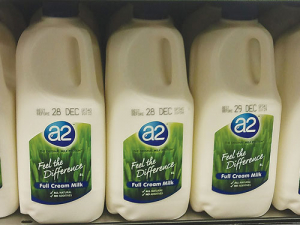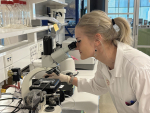New research led by the University of Auckland’s Liggins Institute has found that a2 Milk prevents some symptoms of dairy intolerance and eases others.
This is even though it contains the same amount of lactose as conventional cow milk. The findings of the research, run jointly with AgResearch, were presented at a conference in Chicago on October 22.
Study leader Dr Amber Milan, a study research fellow at the Liggins Institute, says they found a strikingly different pattern of digestive symptoms in people they identified as lactose intolerant after drinking a2 Milk compared to conventional milk.
“a2 Milk (the branded product produced by a2 Milk Company) was at least as effective as lactose-free milk at preventing or easing some of the symptoms of lactose intolerance including nausea, stomach pain and bloating, but didn’t reduce levels of flatulence and gastric reflux,” says Dr Milan.
“The women’s self-ratings of ‘overall digestive comfort’ were the same after a2 Milk as after regular milk, suggesting over the course of 12 hours, the other symptoms were unpleasant enough to not shift overall digestive comfort.”
Conventional milk contains both the A1 and A2 types of beta-casein, a protein comprising 25-30% of total milk protein. It is thought that all cows originally produced only the A2 protein type, and the A1 mutation appeared 5000-10,000 years ago. a2 Milk comes from cows that naturally produce only the A2 type.
“There is some evidence that the symptoms of lactose intolerance may be influenced by the proteins in milk,” says AgResearch senior research scientist Matthew Barnett. “We wanted to investigate this more closely.”
Globally, about 70% of adults consider themselves lactose intolerant, and experience bloating, nausea or other unpleasant symptoms after consuming it.
The study was the first to compare the digestive response to conventional milk, a2 Milk and lactose-free conventional milk between people who are able to digest lactose, people with lactose intolerance and people with dairy intolerance. It was funded by the New Zealand Government High-Value Nutrition National Science Challenge, with co-funding from The a2 Milk Company Ltd.
Participants were 30 healthy young women (aged 20-30, BMI in the normal range) who said they had trouble digesting milk, and a control group of 10 dairy-consuming women. First they drank 50g of lactose – equivalent to about a litre of milk – to determine if they had lactose intolerance or not. Then, on three separate visits, the same women drank 750ml of the three types of milk.
Immediately after the women consumed the milk, and at 30 minute intervals for three hours, the researchers took blood, urine and breath samples, measured their waist and did MRI scans. The women also recorded how they felt for the 12 hours following consumption.
Analysis revealed that the lactose intolerant women:
• did not feel nauseous or have an urgent need to go to the toilet after drinking a2 Milk and lactose-free milk, but did after drinking conventional milk
• had fewer bowel movements over the three hours both after a2 Milk and lactose-free milk compared to conventional milk
• were half as likely to report abdominal pain, fullness and bloating over the course of 12 hours both after a2 Milk and lactose-free milk relative to conventional milk
• experienced a smaller and later rise in breath hydrogen after a2 Milk versus conventional (breath hydrogen is a by-product of gut bacteria digesting any lactose that isn’t absorbed by the body, and is partly responsible for bloating and flatulence)
• experienced the same levels of flatulence and gastric reflux after drinking a2 Milk and conventional milk, self-reported similar levels of “overall digestive discomfort” both after a2 Milk and conventional milk (lactose-free milk was rated most comfortable on this measure).


















